DARBY’S RANGERS SUFFER GRIM END
Cisterna di Littoria, Italy • January 30, 1944
The Allied invasion of mainland Italy began in early September 1943, nearly 6 weeks after the Fascist Grand Council had deposed Germany’s Axis ally Benito Mussolini on July 24–25, 1943, and placed the Italian dictator in detention. Elements of Bernard Law Montgomery’s Eighth Army landed at the coastal city of Reggio Calabria on the Italian “toe” opposite their Sicilian jumping off point on September 3 (Operation Baytown), while the U.S. Fifth Army, Lt. Gen. Mark Clark commanding, landed at the port city of Salerno on Italy’s west coast on September 9 (Operation Avalanche). Four months later, on January 22, 1944, a joint force from the Fifth Army’s VI Corps and the British 1st Infantry Division moved up the west coast to the ports of Anzio and Nettuno (Operation Shingle) in an effort to outflank the Germans’ 3 major east-west defensive lines, collectively known as the Winter Line, that lay between Salerno in the south and Rome, the Italian capital, 40 miles/64 km north of Anzio.
Just inland from Anzio-Nettuno was the small crossroads town of Cisterna di Littoria. In the week between the initial landings at Anzio and 2 U.S. attacks on Cisterna di Littoria, Field Marshal Alfred Kesselring, German Army Group Commander in Southern Italy, had cobbled together a force of 71,500 men attached to the new German Fourteenth Army to stymie the breakout of 69,000 U.S. and British servicemen from their narrow beachhead. On this date, January 30, 1944, the luck of U.S. Army commandos known as Darby’s Rangers (named after its founder and commander) ran out at Cisterna di Littoria.
A West Point graduate, Col. William Orlando Darby (1911–1945) modeled his commandos along the lines of the British. Company A, 1st U.S. Army Ranger Battalion was established on May 27, 1942, and trained with their British counterparts in Northern Ireland and Scotland. In late 1943 the battalion made its first assault against the Axis enemy during Operation Torch, the Allied invasion of Vichy French North Africa. The battalion saw action as part of Operation Husky, the July 1943 invasion of Sicily, where Darby earned his second Distinguished Service Cross. In January 1944 his 6615th Ranger Force (now numbering 3 Ranger battalions and the 509th Parachute Infantry Battalion), formed especially for the Anzio landings, was tasked with taking Cisterna di Littoria following the failure of Maj. Gen. Lucian K. Truscott, Jr.’s U.S. 3rd Infantry Division on January 25–27 to take the town.
Just after midnight on January 30, 1944, 2 lightly armed Darby Ranger battalions were set to infiltrate Cisterna, estimated to be thinly held, and clear the road to Conca 7 miles/11 km to the south preparatory to a daylight attack by a large infantry regiment. Unknown to the Rangers, the Fourteenth Army had moved reserve divisions into the small town. Thus, the Rangers unwittingly advanced on a large, well-equipped enemy force.
At daybreak the Rangers were ambushed on open ground, their infiltration plan evidently uncovered earlier. The 4th Ranger Battalion, assisted by 2 other infantry regiments, failed to rescue their entrapped comrades. By the end of the day the Germans had captured 743 Rangers, cut down 12, and wounded 36. The Battle of Cisterna (January 30 to February 2, 1944) cost 311 Americans their lives and wounded 761; the 3‑day count included 4th Ranger Battalion losses of 30 killed and 58 wounded. Shattered, the Rangers were disbanded. Survivors filled out the ranks of the elite U.S.-Canadian First Special Service Force, famously known as the “Devil’s Brigade,” a Fifth Army commando unit that had landed at Anzio with Darby’s Rangers.
The Tragic Fate of Cisterna di Littoria, January to May 1944
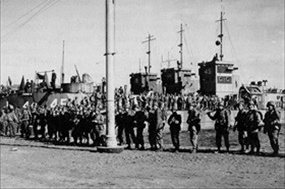 | 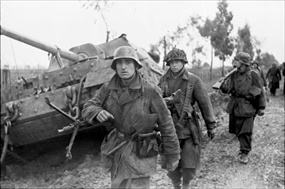 |
Left: Soldiers of Darby’s 3rd Ranger Battalion board landing craft (LCIs) that will take them to Anzio. Two weeks later, nearly every man in the battalion was taken prisoner or killed on the first day of the Battle of Cisterna, January 30, 1944. Only 500 of the 1,500-strong Ranger battalions survived the 3‑day ordeal. Cisterna di Littoria happened to be a node on coastal Highway 7 (Via Appia) and on a rail line running northwest and south. The enemy stronghold straddled the path the U.S. VI Corps needed to take to sever lines of communication with surrounding German armed forces and capture the Italian capital. James Garner, in his first starring role, plays the commando hero in Hollywood’s version of Darby’s Rangers.
![]()
Right: German soldiers advance past an abandoned armored vehicle during the bitter fighting around the Anzio beachhead in early 1944. The Anglo-American landing at Anzio, executed nearly flawlessly, was intended to initiate a lightning strike north against the Eternal City, 40 miles/64 km away. Unfortunately for the Allies, the undersized assault force failed to promptly push off from its beachhead and so Operation Shingle stalled and degenerated into a high-cost battle of attrition until late May.
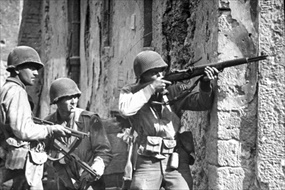 | 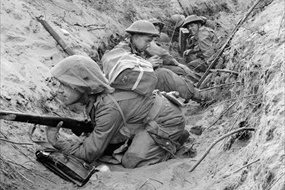 |
Left: A squad from the U.S. 3rd Infantry Division, veterans of the Anzio landings and subsequent fighting, pauses at the corner of a house in Cisterna di Lattoria in late May 1944 as the lead man aims his rifle at a German sniper in the distance. By then the Allies had amassed more troops, now numbering 90,000 men, and more firepower, including air power, for their long-awaited breakout from Anzio. That breakout went through the heavily mined and defended German stronghold of Cisterna.
![]()
Right: A British assault force consisting of 2 British infantry divisions, the 1st and the 5th, participated in the late May attack on Cisterna. In this photo from May 22, 1944, men of Company D, 1st Battalion, 5th Infantry Division, known as the Green Howards, crouch low in a captured communications trench.
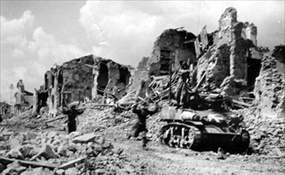 | 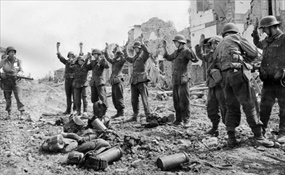 |
Left: Their hands in the air, 2 German prisoners sprint past a damaged American Stuart light tank in this photo, which bears stark evidence of the destruction wrought at Cisterna. When the battle for control of Cisterna was over in late May 1944, only skeletons remained of the town’s burned and battered buildings. A total of 11 Medals of Honor were awarded to American soldiers who made the Anzio beachhead breakout possible. The road to Rome was now wide open, the city falling to the U.S. Fifth Army on June 4, 1944, 2 days before the world’s attention shifted to the Normandy landings.
![]()
Right: These German soldiers fought the Allies in Cisterna to their last bullet before surrendering. Reportedly they sniped at their attackers incessantly from well-prepared defenses. Taken in May 1944 immediately after their capture, the men in this photo are being searched for hidden weapons and their equipment confiscated.
Darby’s Rangers, 1942–1944. Focus on 1st Ranger Battalion
![]()

 History buffs, there is good news! The Daily Chronicles of World War II is now available as an ebook for $4.99 on Amazon.com. Containing a year’s worth of dated entries from this website, the ebook brings the story of this tumultuous era to life in a compelling, authoritative, and succinct manner. Featuring inventive navigation aids, the ebook enables readers to instantly move forward or backward by month and date to different dated entries. Simple and elegant! Click
History buffs, there is good news! The Daily Chronicles of World War II is now available as an ebook for $4.99 on Amazon.com. Containing a year’s worth of dated entries from this website, the ebook brings the story of this tumultuous era to life in a compelling, authoritative, and succinct manner. Featuring inventive navigation aids, the ebook enables readers to instantly move forward or backward by month and date to different dated entries. Simple and elegant! Click 











